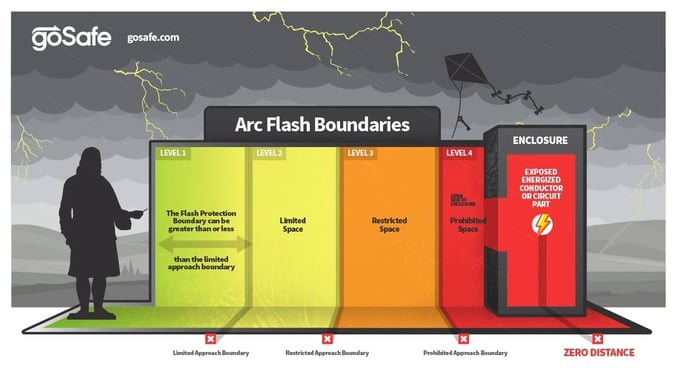Benjamin Franklin could be considered the pioneer of arc flash protection with his invention of the lightning rod. His experiments not only proved that lightning was electricity, but his lightning rods protected homes and saved lives by safely grounding the electricity.
Just as our use of electricity has increased since Franklin's time, so have our methods of arc flash protection.
An arc flash occurs whenever an electric current leaves its course and jumps to the nearest conductor or to the ground. When the flash goes straight to the ground, it is relatively harmless. However, those of us who work around electricity know that electricity often finds its ground by going through the closest human conduit.
When that happens, you need to be protected from the tremendous power of an arc flash. Damage can range on a scale of 0, being a tingling sensation, all the way up to a 4, which is the most dangerous, potentially causing loss of life. Damage is calculated by determining the amount of energy released during an incident and your distance from the source of this energy using the formula cal/cm2. "Cal" stands for calories. All energy is expressed in terms of calories. "Cm2" represents your distance from the energy in terms of centimeters squared.
Damage levels and required protection
Level 0 - Benjamin Franklin best described the minimal amount of damage as, "a universal blow throughout my whole body from head to foot, which seemed within as well as without; after which the first thing I took notice of was a violent quick shaking of my body…." Mr. Franklin was lucky in that he sustained no burns from the arc itself or any flying molten metal. At that time, he was wearing the equivalent of Rating 0 protection gear - untreated cotton, wool or silk were all available both during his experiments and today.
Level 1 - At this level, the electricity itself is a concern. The arc's collateral damage can be worse. Sparks and small amounts of molten metal cause minor skin burns that are easily avoidable with Rating 4 protection gear. This gear includes flame-resistant (FR) shirt and pants or coveralls at a minimum.
Level 2 - Level 2 damage includes potentially worse burns from both the electricity and the collateral damage. Clothing requires Rating 8 protection at this point. This clothing would include all of the previous items and cotton underwear.
Level 3 - A Level 3 incident is near-catastrophic. It will involve arc flashes and/or flying superheated objects. For increased protection, Rating 25 clothing is recommended, which includes everything up to level 8 and adds FR coveralls or cotton underwear, plus two sets of FR coveralls.
Level 4 - This level is the most severe, at which a flash incident has occurred with voltages over 600. At this level, clothing must be rated at a minimum of 40. At this point of danger, all of the other equipment is required as well a multilayer flash suit.
Arc flash safety
Just as your company performs regular fire drills to ensure that everyone knows what to do in case of a fire, you should perform regular arc flash safety compliance checks as part of your energy control program. The National Fire Protection Association established a set of standards for workplace electrical safety. These guidelines ensure your employees' safety when working around electricity, whether as part of a simple machine operation or with live wiring.
The first step is an energy analysis of all parts of your operation, forming the basis of your arc flash safety plan. It provides the information that you need to keep your employees safe through all levels of arc energy incidents.
Next, perform a lock-out/tag-out. While it may seem counterintuitive to create an electrical emergency in your facility, it is easier to check actual responses to the emergency under controlled conditions. You can determine your current level of preparedness and take steps to improve your reaction time and the adequacy of your protective gear. Facility safety is your number one priority so that your employees are protected. This "fire drill" for arc energy safety compliance ensures that your employees are safe when performing their assigned duties.
goSafe recently published a clear, concise guide to a complete energy control program, including outside reference points that provide important additional information. Use this guide as your starting point for your facility safety plan.
In addition to helping your company plan for a disaster, goSafe provides your company with the equipment and supplies needed to prepare for and safely handle a disaster, should one occur. After all, the best plan in the world won't keep your employees safe if you do not have the proper supplies.
Visit us at goSafe to view the complete line of planning tools and safety equipment. We stand ready to assist you in keeping your facility and your employees safe.









